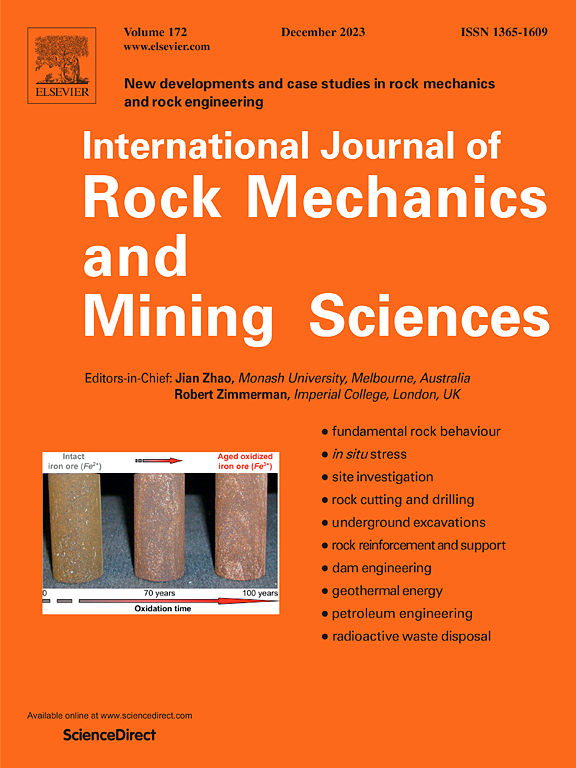A hybrid multiscale model for fluid flow in fractured rocks using homogenization method with discrete fracture networks
IF 7
1区 工程技术
Q1 ENGINEERING, GEOLOGICAL
International Journal of Rock Mechanics and Mining Sciences
Pub Date : 2024-10-18
DOI:10.1016/j.ijrmms.2024.105936
引用次数: 0
Abstract
Fluid flow in subsurface tight reservoirs containing pores, microcracks and macrocracks is notably influenced by the characteristics of macro/micro-cracks. A novel hybrid multiscale model is proposed to address the response of macrocracks and pores/microcracks in different spatial scales. Specifically, an equivalent macroscopic model (EMM) deduced from locally periodic representative element volume (REV) is developed using the asymptotic homogenization method to represent the poroelastic behavior of porous medium with microcracks. Simultaneously, the macrocracks are modeled explicitly using the discrete fracture model (DFM), where the hydraulic properties of cracks influenced by fluid pressure gradient is represented by the nonlinear opening/closure behavior. The obtained hybrid model takes into account the heterogeneous nature of fractured rock masses containing pores, micro/macro-cracks, which is fundamental to describe fluid flow behavior in fracture-matrix system. Specialized finite elements, regular meshing technique and adaptive time stepping algorithm are adopted to improve the computational efficiency. The hybrid multiscale model is firstly validated step by step to demonstrate the accuracy and then used to simulate fluid flow in fractured rock reservoir, shedding light on the underlying mechanisms of the enhanced flow capacity resulting from microcrack distribution, connectivity, and macrocrack stimulation.
利用离散断裂网络的均质化方法建立断裂岩石中流体流动的混合多尺度模型
在含有孔隙、微裂缝和大裂缝的地下致密储层中,流体流动明显受到宏观/微观裂缝特征的影响。本文提出了一种新型多尺度混合模型,以解决宏观裂缝和孔隙/微裂缝在不同空间尺度上的响应问题。具体来说,利用渐近均质化方法,从局部周期性代表元素体积(REV)推导出等效宏观模型(EMM),以表示具有微裂缝的多孔介质的孔弹性行为。同时,利用离散断裂模型(DFM)对大裂缝进行了明确建模,其中裂缝受流体压力梯度影响的水力特性由非线性开/闭行为表现。所获得的混合模型考虑了包含孔隙、微/宏观裂缝的断裂岩体的异质性,这对于描述断裂-基质系统中的流体流动行为至关重要。为提高计算效率,采用了专用有限元、规则网格划分技术和自适应时间步进算法。首先逐步验证了混合多尺度模型的准确性,然后利用该模型模拟了裂缝岩石储层中的流体流动,揭示了微裂缝分布、连通性和大裂缝刺激导致流动能力增强的内在机制。
本文章由计算机程序翻译,如有差异,请以英文原文为准。
求助全文
约1分钟内获得全文
求助全文
来源期刊
CiteScore
14.00
自引率
5.60%
发文量
196
审稿时长
18 weeks
期刊介绍:
The International Journal of Rock Mechanics and Mining Sciences focuses on original research, new developments, site measurements, and case studies within the fields of rock mechanics and rock engineering. Serving as an international platform, it showcases high-quality papers addressing rock mechanics and the application of its principles and techniques in mining and civil engineering projects situated on or within rock masses. These projects encompass a wide range, including slopes, open-pit mines, quarries, shafts, tunnels, caverns, underground mines, metro systems, dams, hydro-electric stations, geothermal energy, petroleum engineering, and radioactive waste disposal. The journal welcomes submissions on various topics, with particular interest in theoretical advancements, analytical and numerical methods, rock testing, site investigation, and case studies.

 求助内容:
求助内容: 应助结果提醒方式:
应助结果提醒方式:


